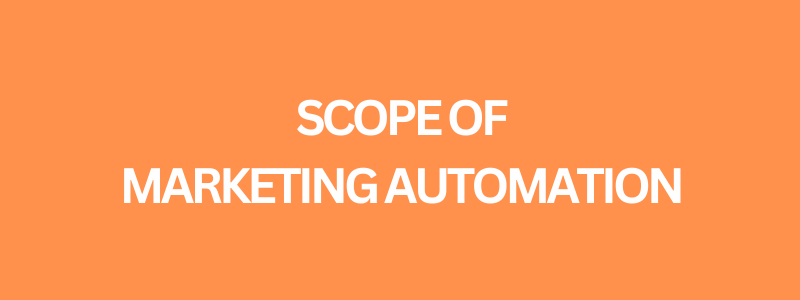In the dynamic landscape of digital marketing, businesses are continually seeking ways to enhance their efficiency and effectiveness. Automation has emerged as a powerful solution, encompassing a wide range of functionalities designed to streamline marketing processes and engage customers on a more personalized level. In this article, we will delve into the comprehensive scope of marketing automation, highlighting the key components that it includes to help businesses thrive in the digital era.

What Marketing Automation Covers?
Lead Generation and Capture:
At the core of marketing automation is the capability to generate and capture leads. It provides tools to create compelling lead capture forms and landing pages, collecting essential information from website visitors, social media followers, and other digital touchpoints. This valuable data forms the basis for targeted marketing campaigns.
Lead Nurturing:
Marketing automation excels in lead nurturing by automating the process of guiding leads through the sales funnel. It allows businesses to create personalized email campaigns that deliver relevant content to prospects at various stages of their buyer’s journey, nurturing them towards conversion.
Personalization:
Personalization is a key driver of engagement in modern marketing. Automation systems use data and insights to personalize marketing messages, ensuring they resonate with each recipient. By tailoring content to individual preferences and behaviors, businesses can increase the likelihood of conversion.
Segmentation:
Successful automation relies on audience segmentation. It enables businesses to categorize their audience based on various criteria, such as demographics, behavior, and purchase history. This segmentation empowers highly targeted marketing campaigns, ensuring that the right message reaches the right audience at the right time.
Email Marketing:
Email marketing is a central feature of marketing automation. These systems facilitate the creation, scheduling, and automation of email campaigns. They also provide detailed analytics to measure the effectiveness of campaigns, including open rates, click-through rates, and conversion metrics.
Analytics and Reporting:
Marketing automation platforms offer robust analytics and reporting tools. Businesses can track the performance of their marketing efforts, measure return on investment (ROI), and make data-driven decisions to optimize future strategies. Analytics provide insights into which campaigns are most effective and where improvements are needed.
Integration:
To create a seamless marketing ecosystem, automation systems often integrate with other tools and platforms. Common integrations include Customer Relationship Management (CRM) systems, social media platforms, e-commerce systems, and analytics tools. Integration ensures a consistent flow of data, enabling businesses to coordinate marketing efforts across multiple channels.
Scalability:
Automation solutions are designed to accommodate businesses of all sizes. They are scalable, allowing organizations to expand and adapt their automation efforts as they grow. This scalability is crucial for long-term success and aligning automation with evolving business needs.
Conclusion
A comprehensive automation strategy is essential for businesses aiming to streamline their processes, enhance customer engagement, and drive growth. The components covered by automation encompass lead generation and capture, lead nurturing, personalization, segmentation, email marketing, analytics, integration, and scalability.